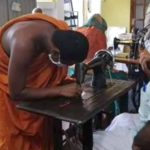A family business
Crafting garlands supported this family for four generations. But competition might bring their family tradition to an end.
“Every day I get up early, around four o’clock in the morning, to fetch flowers. At four in the afternoon I go to town to sell garlands to about 30 regular customers. As far as I know we have been in business for four generations,” says 58-year-old garland-seller Kandiah Parameswaran who lives near the famous Munneswaram temple in Chilaw, an important regional Hindu temple dating back to 1000 CE.
The people who have settled in this area mainly play the thavil (temple drum) and nathaswaram (a musical pipe instrument) and make flower garlands. They generate income by crafting the long floral decorations but the tradition may fade out for this family, as they can no longer support themselves on this trade alone.
“I joined the garland business when I was only seven,” says Parameswaran. “I have four brothers and two of us are in this business. I doubt very much whether there will be anyone to in my family to continue this business after me. All four of my children are female. One of them is a teacher and one is beautician; others are studying. We are unable maintain the family with the meager income we get from this.”
A mulam (arm’s length) of garland was only 25 cents when Parameswaren started in the business, now it is almost ten times the price. Shops buy 4 to 5 arms’ lengths every day to garland photographed swamis (yogis). There are about 30 shops in town that buy garlands regularly, he says. But Parameswaren does not do business with re-sellers, he only orders from the temple: “I don’t get money for the garlands offered to goddess Ambal.”

Everyone learns a bit about the business
“My dad goes to fetch flowers early in the morning from houses in the area,” says Sajithri. “We too grow variety of flowers ourselves in our house. We also get special orders for occasions like weddings, house warming etc.”
“Before going to school every day we help dad make garlands. Everyone in the family knows to make them. My mother is famous for making flowers for hair decorations. Nowadays people come with computer designs for which we need not only flowers but other things such as ribbons and pearls and we make it accordingly. So, even though this is modernized we have also mastered the art of garland making,” she says.
Father Parameswaran says he was practically the only person in the garland business during the civil war (1983 – 2009). Today, people from all over are selling garlands to shops with prices ranging from 30 to 50 rupees and making the profession more competitive.
“Garlanding culture now has also appeared in Kandyan Sinhalese community ceremonies as well. We get flower orders for bridal hair decorations and garlands for grooms. It was not so earlier. So, I order my flowers requirements from Putlam. The price of one measure of flowers is about 150 rupees and I may require 15 to 20 measures. I get down some special flowers from Diyatalawa (up-country). When I go to Sabarimalai, South India I used to bring variety of flowers. I would save 200 rupees from a profit of 500 rupees. Out of this, I can support the family for a week.”
“My only worry is that I have neither a son nor an heir to carry on this business after me,” says Kandiah Parameswaran. “I earnestly pray to goddess Ambal to give me a male offspring. Will my sons-in-law carry on with the service to Ambal? Let us wait and see.”










